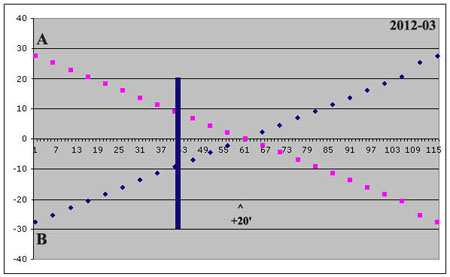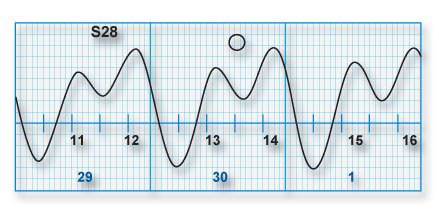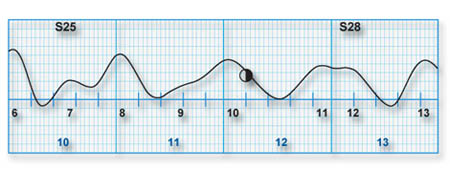
Fusion of two tidal waves.
How a semi-diurnal basin (two tidal waves per day), apparently transforms itself into a diurnal basin (one tidal wave per day).
=====================================================
index tides ||| © copyright notice
===================================================
Apparent variation of the tide cadence.
The cause of this variation is the opposite effect of the declination of the Moon, on the times of the generation of two tide waves.
Figure 1
Ordinates: values of declination (degrees).
Abscisses: values of the times (minutes).
A spatiole above; B spatiole below.

Let's consider a tide generating celestial body (either Moon, or Sun), in a semi-diurnal basin, in the northern hemisphere, when it is above the meridian [curve A, spatiole above]. If it presents a north declination, it acts early. If it has a south declination, it acts late.
Consider the generating body above the opposite meridian [curve B, spatiole below]. If it presents a north declination, it acts late. If it has a south declination, it acts early.
Formation of couples of tidal waves.
The effect of the declinations of the celestial bodies, on the times of the tide generation, modifies the intervals between successive tidal waves, making one interval shorter, and the following one longer, thus forming a series of couples of tidal waves.

Odd number wave, even number wave.
The first tidal wave of each couple is late (relative to the normal time, in case the declination was zero). It is an odd number tidal wave.
The second tidal wave of each couple is early (relative to the normal time, in case the declination was zero). It is an even number tidal wave.
Slow outflow.
In the lagoon of Venice, the interval between the two tidal waves, forming a couple, is even shorter, because of the slow outflow of the odd number tidal wave, out of the lagoon.
If the odd number tidal wave is very late, the even number one is very early too, for the same reason, the declination. The result is a sort of traffic jam.
That's due to the almost automatic alternance of the lags and leads of successive tidal waves, in agreement with the two curves, A and B, of the effects of the celestial bodies declinations.
Example: march 2007.
Let's consider the case occurred on march 12th 2007, and the beginning of the following day.
It is third quarter, when the Moon passes over the meridian during the early morning, and passes over the opposite meridian during the late afternoon.
The Moon declination is 28° south. The morning spatiole will be late (curve A, of the figure 1 above); the afternoon one will be early (curve B).

Between march 12th 2007, and the following day, at Venice, the tidal wave #11 (odd number wave, late) will form a single wave with the following one, the wave #12 (even number wave, early).
Appearance and reality.
The interval between the two tidal waves of a couple sometimes becomes so reduced, that they appear a single wave.
So that a semi-diurnal basin apparently becomes a diurnal basin, while its tide generation remains always semi-diurnal.
Relative to a given tidal basin, the declinations of the generating bodies (Moon, Sun) can only modify the times of the local tide generation. It does not change its daily cadence of generation (diurnal; semi-diurnal).